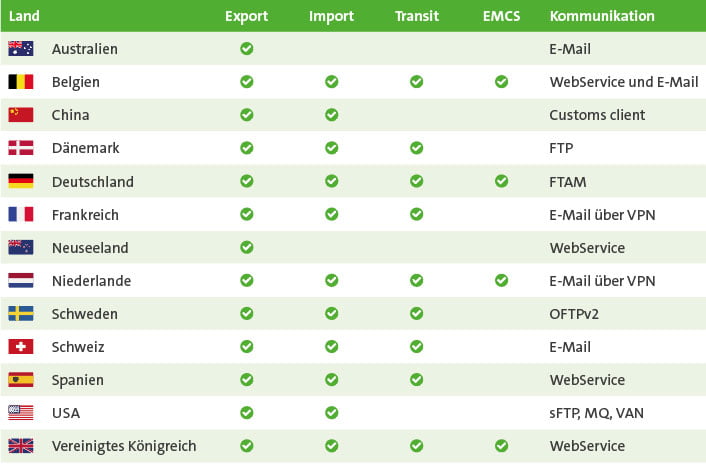A babel fish for international customs clearance


It also works without customs broker
Customs communication is heavily controlled by the customs authorities and is governed by the requirements of the Union Customs Code (UCC). A certified participant software is one of the basic requirements for a company with the status of "authorized economic operator" (AEO) to act as an independent declarant vis-à-vis the customs authorities.
Now, the term "communication" implies that understanding is achieved through the use of signs and language. However, international customs communication is more like the Babylonian confusion of languages. There is only a rudimentary agreement on the use of the same signs and language to achieve understanding in global customs. Customs brokers therefore act as specialists with knowledge of the rules, who are paid dearly for their expertise. But processes that are subject to a set of rules can be standardized. And the more standardized processes are, the easier they are to automate and digitize.
Certified participant software such as SAP GTS is therefore able to ensure direct communication for the export, import, transit and EMCS (Excise Movement Control System) processes by transmitting data quickly and securely with the customs authorities of all the countries it covers (see Fig. 1).

Only half the rent
As a data transmitter, it thus significantly facilitates international customs communication, giving companies clear competitive advantages. It is thus possible to communicate directly with customs authorities electronically and dispense with the cost-intensive services of customs brokers.
However, the mere transmission of data is only half the story. Because the respective formats that are sent and received must be compatible with each other so that an understanding can be achieved and the respective subsequent processes can be triggered. And this is where it gets complex. Customs authorities usually prescribe the technical communication and EDI data format. Although the contents are based on the Union Customs Code (UCC), the customs authorities have found very different solutions here.
Due to the established exchange via e-mail, such as in France or the Netherlands, modern customs systems rely on API-based interfaces. With the introduction of the CDS system, Great Britain relies on a token-based web service to guarantee the secure exchange of customs declarations.
And on top of that, the European authorities are planning extensive changes to the technical interfaces in trade management in the coming year with the NCTS Phase 5 project. This will require adjustments to processes in line with the provisions of the UCC, the introduction of the EU Customs Data Model (EUCDM) and an interface to the AES (Automated Export System) when an export consignment is placed under the transit procedure.
EDI service for SAP GTS
The Seeburger EDI service for SAP GTS supports the customs processes export, import, transit and EMCS (see Fig. 2). Messages from SAP GTS are received, translated into the format required by the relevant customs authority and delivered back to the national customs authority. Running EDI services themselves can be a challenge for some companies. If they don't want to worry about operations, technical monitoring, troubleshooting, security features and required updates, cloud services are a fast and secure solution. A pre-built industry solution enables a quick start to customs integration, regardless of the technology level or geographic distribution of customs. The solution can also be operated on-premises or in the cloud, as well as a fully managed service or in a hybrid model, as required.

Self-Filing with GTS
Especially in times when customers and suppliers can hardly plan reliably anyway due to interrupted supply chains, the shortage of raw materials and congested ports, the prospect of at least getting the goods through customs quickly and smoothly when they do arrive thus secures significant competitive advantages. With approval as an "authorized consignor," the processing time from goods disposition to shipment can ideally be reduced to a matter of minutes by fully automating the data flow to customs, including the automated release of customs authorities. This significantly reduces waiting times for the freight forwarder and optimizes logistics at the goods issue.
So the question arises as to the type of operation: on-premises, fully managed service, iPaaS or hybrid? A cloud solution can be a sensible alternative to in-house operation, particularly in the following scenarios: staff/specialist shortage; upcoming investments in new solutions or significant expansions; increasing operational requirements (24/7 operation); or if the costs of in-house operation (hardware, software, staff training, support) exceed the costs of a transparently calculable cloud service.
In the case of business-critical customs processes with direct impact on international shipping, as described above, a solution such as Seeburger EDI Service for SAP GTS as a cloud service has advantages over an on-premises installation.
SAP and Seeburger have been working together on the development of the SAP GTS product offering since 2005. As part of this long-standing partnership with SAP, Seeburger has established a "competence center" to support GTS customers in the areas of development, support, consulting and operations. In close cooperation with the GTS team, Seeburger develops the message conversions and connections to the supported customs authorities and many customs brokers.
In addition, Seeburger supports SAP in the certification processes to meet the various customs requirements. Here, the company takes over all tasks that are necessary for the secure and highly available operation of the integration platform. No matter whether data center operation, database maintenance, security updates or even the connection of new customs authorities.
Seeburger EDI services for SAP GTS are thus like a babel fish for international customs processing. They ensure that technical communication works in all directions - whether on-premises or as a cloud service. (Don't know what a babelfish is? Then I recommend you read Douglas Adams' cult novel "The Hitchhiker's Guide to the Galaxy").







